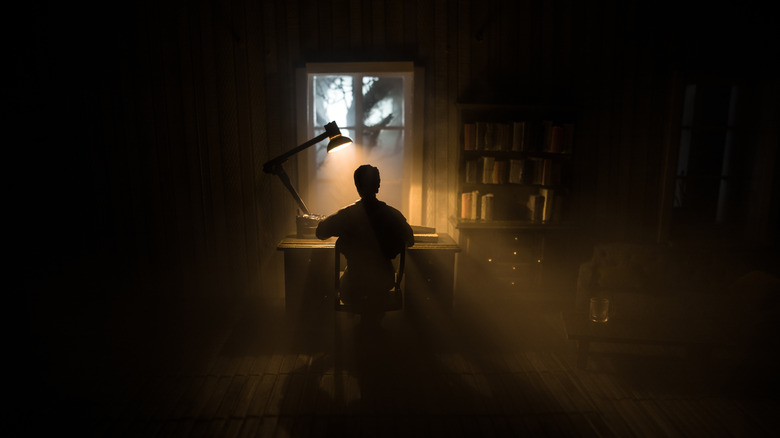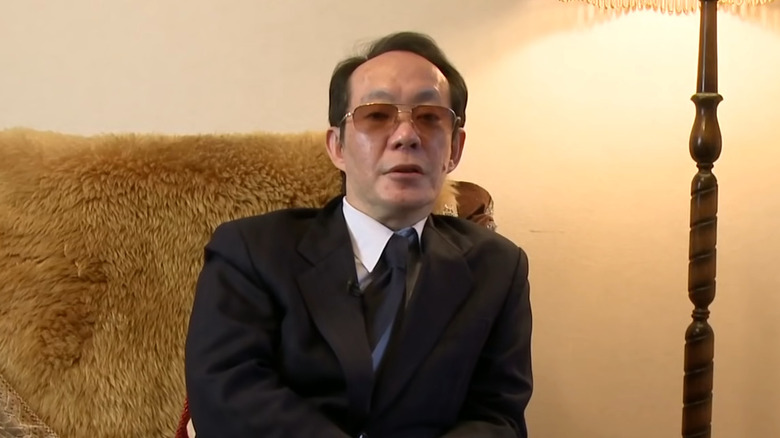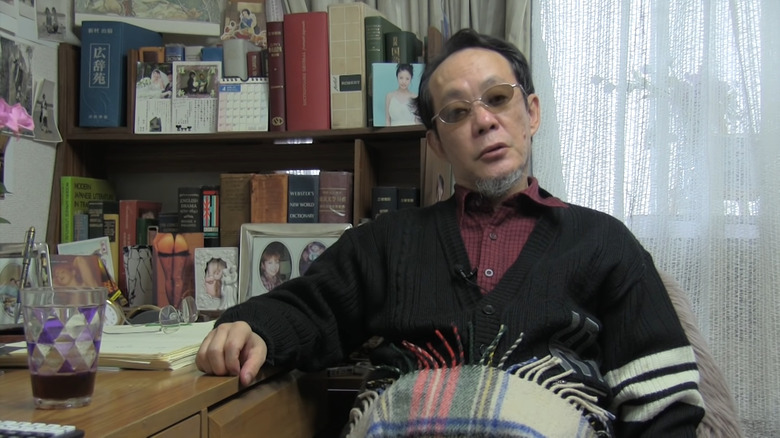Cannibal Issei Sagawa Escaped Punishment And Became A Well-Known Author
The following article includes details of cannibalism and necrophilia.
Issei Sagawa became a celebrity in his home country of Japan after he fulfilled his lifelong wish, that is, to eat a human being. He was dubbed the Kobe Cannibal, and gained enough notoriety that his crime even became an inspiration for a verse in the Rolling Stones song titled "Too Much Blood." Despite the atrocity of his actions, Sagawa never paid for his crimes.
Sagawa was born prematurely on April 26, 1949, in Kobe, after his mother fell down the stairs. He was so small that he fit on his father's palm, and he also developed enteritis — the inflammation of the small intestine — as a baby. According to New Criminologist, Sagawa's interest in cannibalism started when he was just a boy. In fact, his favorite fairytale was "Hansel and Gretel," and he was delighted by the idea of the witch fattening up the children before consuming them. In school, Sagawa kept to himself but was a good student. As he hit puberty, he wondered what a female human tasted like and he often pleasured himself with visions of cannibalism.
Sagawa knew that his thoughts were not typical of a teenage boy. At 15 years old, he contacted a psychiatrist over the phone about his obsessive thoughts on cannibalism. The doctor wanted to meet with the boy personally to be able to help him, but Sagawa refused. His dark thoughts festered for years, and he was 32 years old when he acted on his urges.
The Cannibal in Paris
In the late 1970s, Issei Sagawa moved to Paris to pursue a Ph.D. in literature at Sorbonne University. In later interviews, he recalled often bringing home sex workers and attempting to kill them but he never pushed forward with his plans (via ATI). "It became less about wanting to eat them, but more an obsession with the idea that I simply had to carry out this 'ritual' of killing a girl no matter what," he wrote in his book. It was at the university where he met a beautiful Dutch student named Renée Hartevelt, who eventually became his friend. One night, Sagawa invited Hartevelt to his apartment under the guise of needing help with studying German. While there, Sagawa shot the young woman and had sex with her dead body.
Sagawa cut into Hartevelt's body and ate parts of her buttocks, breasts, and thighs. Some of the flesh he ate raw, and others he cooked. He kept parts in the freezer as well. In an interview with Vice in 2009, Sagawa claimed that although he wanted to eat a woman, he didn't really want to murder anyone. After killing Hartevelt, he felt a moment of regret. "I realized that I had lost an important friend ... Nobody believes me, but my ultimate intention was to eat her, not necessarily to kill her," he said.
How he was caught
Issei Sagawa realized that he had to get rid of the remains when his apartment started to smell a couple of days after the murder. He placed the remains in two suitcases and hailed a taxi to bring him to Bois de Boulogne park where there was a lake. As the taxi driver helped Sagawa load the suitcases into the cab, he said, "What have you got in here? A dead body?" (via The Guardian). He arrived at the park before sunset, and there were people who noticed that blood was seeping out from the suitcases. They alerted authorities, and Sagawa was apprehended shortly after.
As reported by ATI, Sagawa didn't deny his crime when the police questioned him. "I killed her to eat her flesh," he told them. He gave the police a detailed account of what happened and even said that now that he had fulfilled his fantasy, he would never have to do it again. Years later, however, he still had the same urges, he admitted in an interview with Vice. "The desire to eat people becomes so intense around June, when women start wearing less and showing more skin," he stated.
Justice was not served
Issei Sagawa was arrested, but his case never went to trial. Examining Magistrate Louis Bruguiéres flew to Japan to interview Sagawa's family and doctors to gain insight about the cannibal killer. Despite hours of interviews with several people, the magistrate wasn't able to determine what prompted Sagawa to commit such a horrendous act, as reported by New Criminologist. Sagawa's father, an affluent businessman, traveled to Paris and hired the best lawyer for his son's defense. In 1982, a judge declared Sagawa unfit for trial due to insanity, and he was ordered to be confined in a facility for the criminally insane. The public was outraged about the decision.
In 1984, Sagawa was deported back to his home country. Japanese medical professionals didn't find him insane, but they thought of him as evil. They said he only had a "character anomaly," according to the Japan Times. The professionals all agreed that he belonged in prison and not in a mental health facility. However, French authorities closed his case and his files were sealed upon his deportation. Japanese authorities attempted to gain access to his case files but the French refused the request. Without key evidence and information about the crime, Japan couldn't prosecute the cannibal. Sagawa was a free man.
Issei Sagawa wrote a book about his crime
The Kobe Cannibal capitalized on his crime. He wrote a book titled "Kiri no Naka," which translates to "In the Fog," and in it, he wrote in explicit detail the murder of Renée Hartevelt and even vividly described how human flesh tasted. Sagawa enjoyed his notoriety and granted interviews to anyone who wanted to speak with him. As reported by Vice, he even starred in some adult films that recreated his crime. He also guested on cooking shows where he ate raw meat. Sagawa became the subject of documentaries, articles, and even manga (Japanese comic books) in the years after the murder took place, and he became a minor celebrity.
Lucien Castaing-Taylor, the co-director of the documentary "Caniba," said Sagawa loved the media attention and candidly discussed the crime he committed. "In his media representations, he didn't acknowledge doing anything wrong. We saw no expressions of remorse," the director told the New York Post. Sagawa became a best-selling author and wrote 20 books in his lifetime.
Issei Sagawa's death
In a 2009 interview with Vice, Sagawa discussed his ideal manner of death. He said that he wanted a beautiful woman to kill him. Furthermore, he stated that instant death was "boring." He wanted to die by drowning in a woman's saliva and stated that it was his "ultimate dream." "I'm a cowardly man who killed another person, yet I can't face killing myself. So I guess dying at the hands of a woman would be my way to redemption," he stated.
By 2015, Issei Sagawa had survived two heart attacks and was suffering from diabetes. As reported by the New York Post, most of his family members had deserted him, and he was being cared for by his brother, Jun. He suffered a stroke as well and was using a wheelchair. Sagawa died of pneumonia on November 24, 2022, at 73 years old. The funeral was private and only his family members attended.





